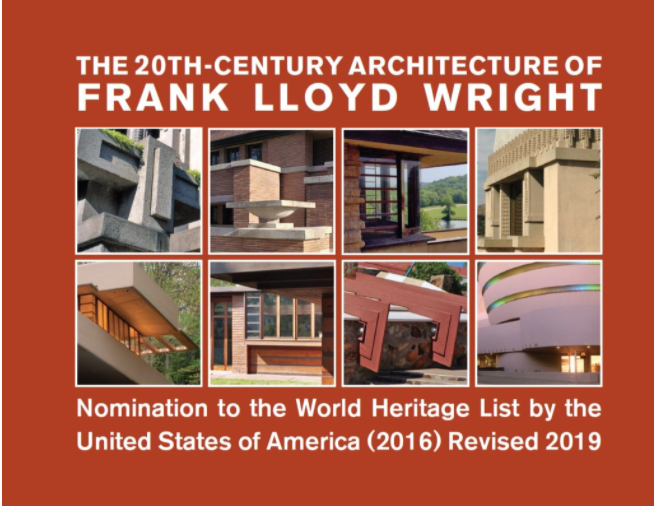Part One in a series about “The 20th-Century Architecture of Frank Lloyd Wright” World Heritage listing
Two years ago, eight buildings designed by Frank Lloyd Wright were officially inscribed on the World Heritage List. Known collectively as The 20th-Century Architecture of Frank Lloyd Wright, the sites were carefully selected to best exemplify Wright’s creative genius and his profound contribution to modern architecture and culture. Since then most of the sites have been closed to the public due to the global Covid-19 pandemic. As our sites cautiously reopen and travel again becomes a possibility, we hope you’ll enjoy this primer on World Heritage and the Frank Lloyd Wright World Heritage serial inscription (as multi-site designations such as this one are known).
World Heritage: Marker of Distinction and Commitment to Protection
The origins of World Heritage lie in an international treaty formally named the Convention concerning the Protection of the World Cultural and Natural Heritage (aka “the World Heritage Convention”), adopted by the United Nations Education, Scientific and Cultural Organization (UNESCO) in 1972. The U.S. was instrumental in developing the World Heritage Convention and was proud to be its first signatory. The Convention promotes cooperation among nations to protect sites of “outstanding universal value” for current and future generations. Participating countries do this by identifying these sites within their own boundaries and submitting these for consideration to the World Heritage Committee.
World Heritage designation guarantees distinction and promotes protection. This is why World Heritage Sites are such popular tourist destinations around the world: they have been determined by their own countries and the World Heritage Committee to possess Outstanding Universal Value and have conservation plans to conserve them for posterity. World Heritages Sites in the U.S. include Yosemite, Yellowstone, and Grand Canyon National Parks; Mesa Verde and Chaco Culture National Historical Parks; and the Statue of Liberty and Constitution Hall in Philadelphia.
There are many organizations that assist in the selection and designation of World Heritage Sites. The International Council on Monuments and Sites (ICOMOS) provides expert guidance on cultural sites. In the United States, US/ICOMOS works with potential World Heritage Sites and the National Park Service Office of International Affairs (NPS-OIA), which oversees the nomination process.
“The 20th-Century Architecture of Frank Lloyd Wright” World Heritage Listing
Sites approved for inclusion on the World Heritage List must be deemed of outstanding universal value and meet at least one of ten selection criteria. The eight Wright sites making up “The 20th-Century Architecture of Frank Lloyd Wright” serial designation are listed under Criterion 2, as they “exhibit an important interchange of human values, over a span of time or within a cultural area of the world, on developments in architecture or technology, monumental arts, town-planning or landscape design.”
In serial World Heritage listings, “it is the series, and not necessarily each of its components taken individually, which is of outstanding universal value.” In this case, the eight Wright sites as a group were produced during an era—the first half of the twentieth century–characterized by dramatic technological and social change particularly in regard to industrialization. Individually, the eight buildings embody new solutions to the early 20th century’s rapidly changing needs for housing, worship, work, education and leisure. As a group, their Outstanding Universal Value lies in Frank Lloyd Wright’s lasting impact on architecture and culture. The buildings reflect the “organic architecture” developed by Wright, characteristics of which include an open plan, a blurring of the boundaries between exterior and interior, and the novel use of materials such as steel and concrete.
Get Involved
The eight Frank Lloyd Wright-designed sites are all managed separately (or dually, in the case of Taliesin and Taliesin West) but it took years of teamwork to develop the Frank Lloyd Wright serial listing and it takes continued group effort to maintain it. Before inscription, Lynda Waggoner, former Director of Fallingwater, devoted decades to developing and re-developing the nomination, along with the NPS-OIA and the Frank Lloyd Wright Building Conservancy (FLWBC). US/ICOMOS provided expert guidance and site review. The eight sites worked together on the nomination and continue cooperation as the Frank Lloyd Wright World Heritage Council. The FLWBC and its Executive Director, Barbara Gordon, work closely with the Council.
Over the course of this series, we will feature the eight individual sites included in “The 20th-Century Architecture of Frank Lloyd Wright.” We hope that you will visit them all. We also hope that you will support the institutions behind the World Heritage Listing and World Heritage in the U.S. and around the world.
- US/ICOMOS: become a member, donate, and subscribe to our newsletter
- Frank Lloyd Wright Building Conservancy: become a member, donate, and subscribe to our newsletter
Our next essay will feature the Robie House (Chicago, Illinois) and Unity Temple (Oak Park, Illinois) the two earliest sites included in the World Heritage listing.


1 Comment.
[…] Part Two in a series about “The 20th-Century Architecture of Frank Lloyd Wright” World Heritage listing. (If you missed Part 1, read it here.) […]